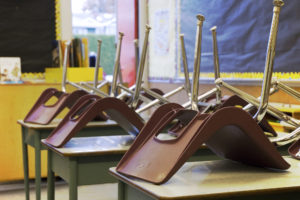With the school year coming to a close, some of our parish and school buildings will be unoccupied for the summer months. Please take steps now to protect your unoccupied buildings from theft, vandalism, and property damage.

Unoccupied Building Risks
Buildings that are unoccupied are subject to greater risk from certain types of perils. An interruption of utility service, vandalism, or even a faulty furnace can cause significant damage if it goes undetected. Implementing loss control measures can help avoid damages and costly property and liability claims. Inspecting and ongoing monitoring of these properties is the key to protection.
Before Shutting Down
Before shutting down for the summer months, take an inventory of your building and grounds. Are drains unobstructed? Are sump pumps operational? Are all windows and doors in good repair and equipped with functioning locks? Have the fire and smoke detectors systems been tested? Are you able to account for all keys to the building? Remember to remove all perishables from the refrigerator, unplug the unit and leave the door open to promote air circulation. For more suggestions, please see download our Unoccupied Building Checklist.
During the Summer Months
Be sure a plan is in place to maintain the grounds on a regular basis, including mowing lawns, trimming shrubbery and pruning trees. Plan on-the-ground inspections at least weekly. Always visit your facility after heavy storms or during extended periods of high humidity. Look out for the following:
- Check entrances to ensure they are secured
- Check window panes for breakage and make sure locks are intact
- Look for signs of vandalism, graffiti, or attempted break-ins
- Inspect for evidence of pest intrusion or insect damage
- Remove any debris from the grounds
- Check interior for any signs of leaks, condensation or water accumulation
- Test and, if necessary, change exterior light bulbs
In addition to the on-the-ground inspections, you may want to conduct drive-by surveillances. At the very least, inform local police that the building will be unoccupied and request that they routinely drive by the building, especially in the evening.
After a Storm
Always inspect the facility and adjourning buildings (even if occupied) after a heavy rainstorm, starting with the basement and boiler rooms. If leaks or flooding occur, you will want to make repairs and address water issues as soon as possible. If upon entering the building you smell gas or suspect a leak, leave the building immediately and contact the gas company or fire department.
Inspect the grounds and look for fallen branches or broken branches still attached to the tree. Large branches that are broken should be cut back to the trunk or a main limb by an arborist.
If power lines are lying on the ground or dangling near the ground, do not touch them. Notify your utility company as soon as possible that the lines have been damaged, or that the power lines are down. Do not attempt to move or repair the power lines.
Preventing Vandalism
Doors and windows need to be locked and in good repair. Greenery should be removed so there is a clear view of the windows and doors. Ensure that adequate exterior lighting is available and functioning. This will not only help deter criminals, but will also help personnel establish a quick visual assessment in the event of a broken window or other vandalism. Keep shades/blinds up so police or neighbors can see individuals inside the building during off hours. Broken windows or doors need to be quickly repaired or boarded up to deter vandalism and trespassing.
Mold Prevention
When buildings are unoccupied during the summer months, one of the biggest threats is mold growth. The risk for mold growth is especially high during extended periods of hot, humid weather, when it can begin to grow on wet walls, carpets or flooring within 24 to 48 hours. Please take these steps to prevent mold:
- Reduce indoor humidity by keeping moisture below 60% relative humidity. Between 30 and 50% is ideal. Use a small, inexpensive moisture/humidity meter from a hardware store to measure relative humidity.
- Control humidity levels and dampness by using air conditioners and de-humidifiers.
- Provide adequate ventilation. Keep interior doors open and cross-ventilate when possible.

